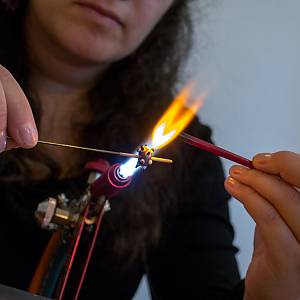Last year in November, Venice was hit by the worst flood we ever experienced during the last 53 years. Because of all the Perleri, Impiraresse and Maestri laboratories are at the ground floor, quite all their places, instruments, tools and materials were strongly damaged.
It took months to refurbish, renovate and deeply clean their places and they had to rebuy many of their instruments, tools and materials. A large part of their drawings and researches written on copybooks were lost. Perleri, Impiraresse and Maestri have been again in condition to work in February 2020 at the occasion of Carnival of Venice.
Due to the pandemic situation, Carnival was stopped at the end of February and, successively, due to the lockdown (started on March 8th), Perleri, Impiraresse and Maestri were not allowed to get into their laboratories until May 4th so, without their instruments and tools they hadn’t the possibility to work.
In June 2020, the community had a very painful loss: because of the strict interconnection between people making part of our community (also civilians) and the absence of social practices to which they are used, they experienced and are experiencing a lack of passion and stimulus.
Transmission has also been deeply affected by the pandemic. The impossibility for the community to stay close to each other, to share their information in presence, to see and amend their movements (touches to amend movements, gesture and proximity are a fundamental part of their way to transmit their know-how and social practices) is a current challenge: according to Perleri, Impiraresse and Maestri, pandemic also affected the will of younger people to learn how to practice this art because of the distancing rule.
Among specific examples adopted by community in response of Covid situation there are:
- Transmission (formal and not formal) isn’t actually taking place (both in laboratories and school because of the rules given by the Italian State to contain the pandemic).
- Some laboratories reopened in May, others in September at the occasion of Venice Glass Week.
- All the members of the community are strictly in touch for discussing the current situation and trying to think to possible solutions for the safeguarding of this living heritage.
- Locally, there were organized several events (6 in total) for the Venice Glass Week 5-13 September.
- The community is constantly in touch with the City of Venice and Fondazione Musei Civici di Venezia for planning future meetings (as happened in Padiglione Venezia – Biennale d’Arte di Venezia on September 12th).
- Thanks to MIBACT (Segretariato Generale Servizio II-UNESCO Unit) there was organized on the August 24th a meeting between ICH communities that gave to all of us the opportunity to see how important is the net especially during these pandemic circumstances.
- In Venice, places and this knowledge are inextricably linked, so much so that the City of Venice, during the Venice Glass Week, have named some streets and squares to elements and female figures such as Marietta Barovier (Perlera) linked to the Rosetta bead.
Las designaciones utilizadas y la presentación de los textos y documentos presentados en esta plataforma no suponen ninguna toma de posición por parte de la UNESCO acerca de la condición jurídica de los países, territorios, ciudades o zonas ni respecto al trazado de sus fronteras o límites.
